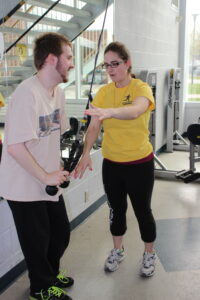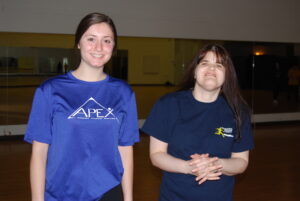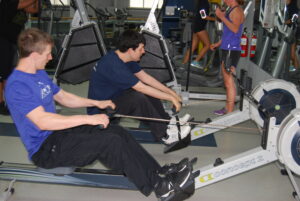Exercise leads to many benefits for individuals with intellectual and developmental disability (IDD), including those diagnosed with autism spectrum disorder (ASD). These include improved physical and mental health, increased community engagement, and, amongst individuals with ASD, a decrease in repetitive behaviours that often result in functional and social impairment. The Adapted Physical Exercise (APEX) Research Group at the University of Windsor, in collaboration with Community Living Essex County, provides inclusive, barrier-free sport and physical activity programming for adults with IDD. Based on nearly a decade of APEX programming and research (see the SIRCuit article on some of our findings), this blog provides recommendations for program leaders to adapt sport and physical activity to make it inclusive for adults with IDD.
About the program

APEX programming matches people receiving services with volunteer student trainers for a one-on-one, 12-week program at the campus fitness facility. Programming involves individualized exercise sessions that consist of a warm-up, cardiovascular training, whole-body strength training using weight machines and free weights, a sports and games component that provides an opportunity for unstructured play in a group setting, and a cool-down that includes static stretching. Sessions occur twice per week for 90 minutes, and participants are often accompanied by a support worker or guardian. Based on program evaluation with leaders and a series of in-depth case studies with APEX participants (Ali et al., 2018, April; Ali et al., 2018a; 2018b), the following tips and strategies were identified to support engagement. While some findings were specific to each participant, they provide general guidelines and suggestions for similar programs in other communities working with adults with IDD, and ASD in particular.
Key tips for programs and practitioners
1. Hold a familiarization session prior to each program. This allows participants and their support workers or guardians to meet the student trainer and become comfortable with the gym environment, fitness equipment, and data collection procedures.
2. Simplify complex movements into small components. For example, a toe-touch stretch can be broken down: 1) raising hands above your head, 2) bending at the waist, and 3) reach your hands towards your toes.
3. Encourage participants to exercise at a pace that is comfortable to them. If a participant appears to be fatiguing early as a result of pushing themselves too hard, their trainer could try exercising with them at the desired tempo or chanting a song at a reduced cadence. Recognize that signs of fatigue vary across individuals. Examples include heavy breathing, redness/flushed face, yawning, spontaneously halting exercise, and exaggerated movements.
4. Alter the environment to the participant’s unique needs. This could mean lowering or raising the temperature if in a small room, minimizing visual distractions, or moving to a preferred location within the gym, such as near a window.

5. Use individualized tracking sheets and take detailed notes on participants’ mood and preferences. Doing this every session will help to discern between changes in a participant’s progress and alterations in their mood. Adapting to participant preferences will aid in motivation and enjoyment during exercise sessions.
6. Create a detailed profile of each individual’s repetitive behaviours. Work with support staff or guardians to understand how certain gestures and repetitive behaviours may be used to facilitate communication in an exercise setting. Remember not all repetitive behaviours are detrimental – some can be considered positive when they express a positive mood or enthusiasm (Ali et al., 2018b). Research evidence suggests the best exercise interventions for repetitive behaviours in people with ASD are vigorous in intensity, aerobically based (i.e., jogging), and individually focused (Ali et al., 2018a). Consider focusing on these programming components if attempting to address maladaptive repetitive behaviours.
7. Schedule some programming during normal hours of operation in a fitness facility. This gives gym members and staff an opportunity to learn and better understand the abilities of persons with a disability, and may ultimately lead to more inclusionary practices. Rather than running a program in a segregated room, ideally programming would take place where everyone is getting “fit together.”
8. Consider a 1:1 participant:trainer ratio along with an engaged support worker. This seems to be optimal, although we recognize that this may not be feasible for all programs.

9. Experiment with motivational and verbal encouragement strategies:
- Implement chants and songs to encourage participation.
- Break down program components into time segments (e.g., “5 minutes left”).
- Exercise alongside the participant (e.g., using an adjacent stationary bike).
- Redirect focus back to the exercise modality (e.g., imaginary racing game while participant is on the stationary bike).
- Stay open to mid-session adjustments (e.g., using a new motivational strategy based on select repetitive behaviours you’ve observed).
10. Download the Apex Exercise Manual for more ideas and support. Our practical manual about exercise programming for adults with development disabilities, and accompanying exercise video catalogue, provide practical ideas and insights based on our research and programs over the last decade.
Conclusion
Strategies to adapt exercise programming for individuals with IDD must be dynamic, as these participants have varying needs, abilities, strengths, and preferences. For example, we noticed that changes in repetitive behaviours were highly individualized, and that some repetitive behaviours were linked, such that as one behaviour decreases in frequency another may increase. Sports Illustrated recently highlighted the sporting accomplishments of several athletes with ASD, and how their unique characteristics, such as select repetitive behaviours, may contribute to their success. Sport leagues, athletic programs, and exercise-as-medicine research should continue to embrace the individuality in this heterogenous population.
Acknowledgement
We would like to thank Community Living Essex County, our funders, The University of Windsor’s Department of Athletics and Recreation Services, and most importantly, our participants, support staff, and families for their support and efforts. Please see our accompanying SIRC article for some of the outcomes that participants have experienced through APEX, as well as what people involved with the program have had to say about it, and implications for sport policy.
Community Living Essex County: https://communitylivingessex.org/
APEX Research Group: https://www.uwindsor.ca/kinesiology/APEX